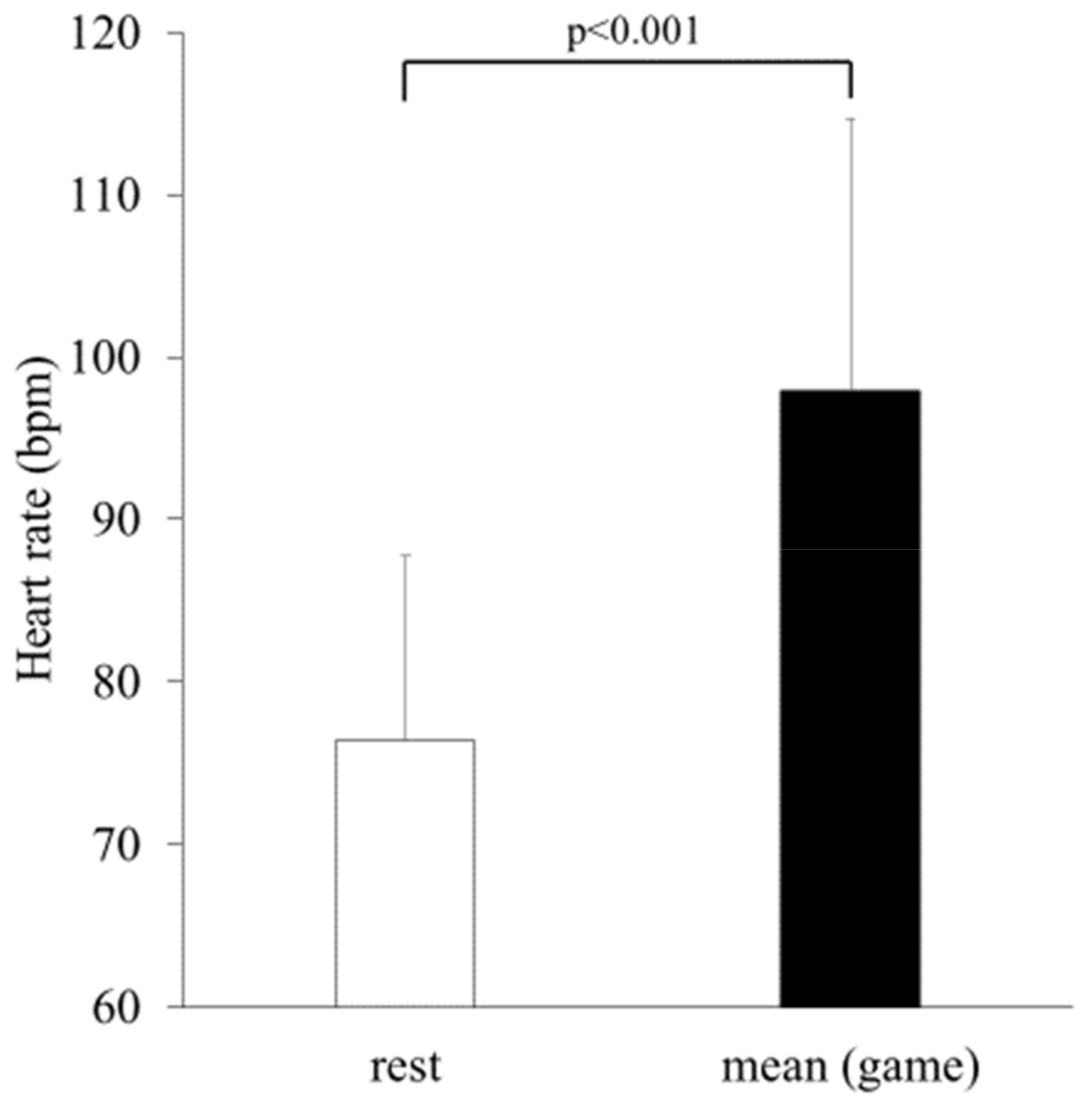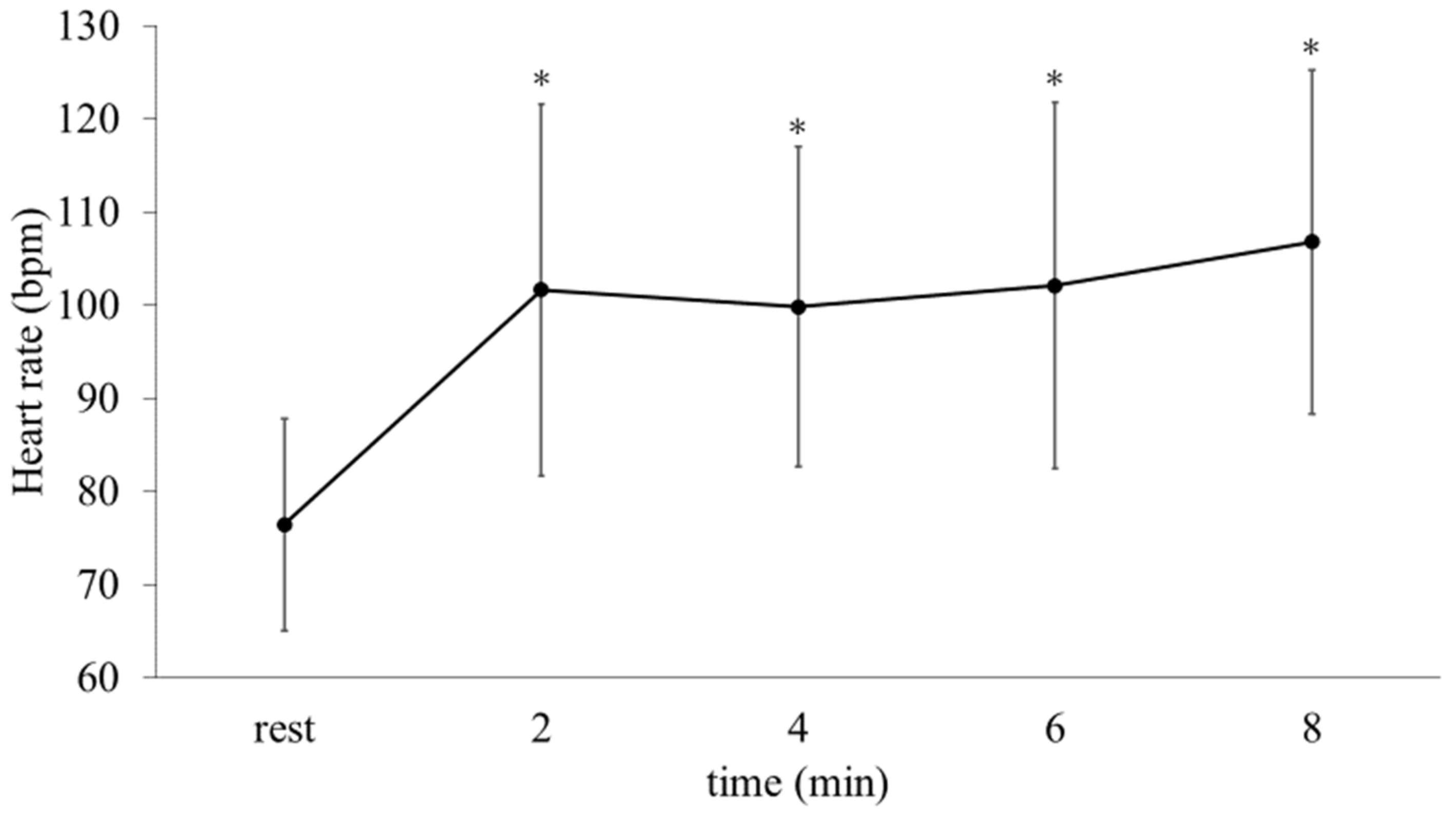Esports for Seniors: Acute Effects of Esports Gaming in the Community on the Emotional State and Heart Rate among Japanese Older Adults
Abstract
:1. Introduction
2. Materials and Methods
2.1. Participants
2.2. Study Protocol (Figure 1 and Figure 2)


2.3. Profile of Mood States (POMS)
2.4. Heart Rate and Blood Pressure
2.5. Statistical Analysis
3. Results
3.1. Participants
3.2. POMS (Table 1, Figure 3a,b)
- Positive affect
- Negative affect
| Pre | Post | p-Value | |
|---|---|---|---|
| Anger | 2.2 ± 2.3 | 1.7 ± 2.6 | 0.180 |
| Confusion | 4.0 ± 2.7 | 4.3 ± 3.3 | 0.702 |
| Depression | 3.3 ± 3.0 | 3.0 ± 4.1 | 0.394 |
| Fatigue | 3.7 ± 3.6 | 5.8 ± 4.3 | 0.004 |
| Tension | 5.6 ± 3.6 | 7.2 ± 4.0 | 0.038 |
| Vigor | 11.1 ± 4.3 | 13.4 ± 3.6 | 0.021 |

3.3. Heart Rate and Blood Pressure (Figure 4 and Figure 5, Table 2)


| Pre | Post | p-Value | |
|---|---|---|---|
| Systolic blood pressure (mmHg) | 150.4 ± 23.7 | 153.4 ± 17.6 | 0.408 |
| Diastolic blood pressure (mmHg) | 78.3 ± 13.2 | 79.5 ± 13.3 | 0.475 |
4. Discussion
5. Conclusions
Author Contributions
Funding
Institutional Review Board Statement
Informed Consent Statement
Data Availability Statement
Acknowledgments
Conflicts of Interest
References
- Trotter, M.G.; Coulter, T.L.; Davis, P.A.; Poulus, D.R.; Polman, R. The association between esports participation, health and physical activity behaviour. Int. J. Environ. Res. Public Health 2020, 17, 7329. [Google Scholar] [CrossRef] [PubMed]
- Karhulahti, V.M. Reconsidering esport: Economics and executive ownership. Phys. Cult. Sport Stud. Res. 2017, 74, 43–53. [Google Scholar] [CrossRef]
- Newzoo. Newzoo’s Global Esports & Live Streaming Market Report 2021. Free Version. Available online: https://newzoo.com/insights/trend-reports/newzoos-global-esports-live-streaming-market-report-2021-free-version (accessed on 16 August 2022).
- Rudolf, K.; Bickmann, P.; Froböse, I.; Tholl, C.; Wechsler, K.; Grieben, C. Demographics and health behavior of video game and esports players in Germany: The esports study 2019. Int. J. Environ. Res. Public Health 2020, 17, 1870. [Google Scholar] [CrossRef] [PubMed]
- DiFrancisco-Donoghue, J.; Werner, W.G.; Douris, P.C.; Zwibel, H. Esports players, got muscle? Competitive video game players’ physical activity, body fat, bone mineral content, and muscle mass in comparison to matched controls. J. Sport Health Sci. 2020. [Google Scholar] [CrossRef]
- Peracchia, S.; Curcio, G. Exposure to video games: Effects on sleep and on post-sleep cognitive abilities. A sistematic review of experimental evidences. Sleep Science. 2018, 11, 302–314. [Google Scholar] [CrossRef]
- Zimmer, R.T.; Haupt, S.; Heidenreich, H.; Schmidt, W.F.J. Acute effects of esports on the cardiovascular system and energy expenditure in amateur esports players. Front. Sports Act. Living 2022, 4, 824006. [Google Scholar] [CrossRef]
- Sousa, A.; Ahmad, S.L.; Hassan, T.; Yuen, K.; Douris, P.; Zwibel, H.; DiFrancisco-Donoghue, J. Physiological and cognitive functions following a discrete session of competitive esports gaming. Front. Psychol. 2020, 11, 1030. [Google Scholar] [CrossRef]
- Watanabe, K.; Saijo, N.; Minami, S.; Kashino, M. The effects of competitive and interactive play on physiological state in professional esports players. Heliyon 2021, 7, e06844. [Google Scholar] [CrossRef]
- Andre, T.L.; Walsh, S.M.; ValladÃo, S.P.; Cox, D. Physiological and perceptual response to a live collegiate esports tournament. Int. J. Exerc. Sci. 2020, 13, 1418–1429. [Google Scholar]
- ValladÃo, S.P.; Middleton, J.; Andre, T.L. Esport: Fortnite acutely increases heart rate of young men. Int. J. Exerc. Sci. 2020, 3, 1217–1227. [Google Scholar]
- Schmidt, S.C.E.; Gnam, J.P.; Kopf, M.; Rathgeber, T.; Woll, A. The influence of cortisol, flow, and anxiety on performance in E-sports: A field study. Biomed. Res. Int. 2020, 2020, 9651245. [Google Scholar] [CrossRef] [PubMed]
- Gündoğdu, S.; Çolak, Ö.H.; Doğan, E.A.; Gülbetekin, E.; Polat, Ö. Assessment of mental fatigue and stress on electronic sport players with data fusion. Med. Biol. Eng. Comput. 2021, 59, 1691–1707. [Google Scholar] [CrossRef] [PubMed]
- Kari, T.; Karhulahti, V.M. Do E-athletes move?: A study on training and physical exercise in elite E-sports. Int. J. Gaming Comput. Mediat. Simul. 2016, 8, 53–66. [Google Scholar] [CrossRef]
- Parker, L. The Next Generation of Competitive Gamers Is…over 60? Available online: https://www.wsj.com/articles/the-next-generation-of-competitive-gamers-isover-60-11557842405 (accessed on 14 July 2022).
- Chen, A. CS: GO World Champion DieHardBirdie Recruits for All-Senioresports Team. Available online: https://beta.upcomer.com/csgo-world-champion-diehardbirdie-recruits-for-all-senior-esports-team. (accessed on 14 July 2022).
- Takano, H. Japan Gets First Pro Esports Team Made up Entirely of Elderly Players. Available online: https://mainichi.jp/english/articles/20210922/p2a/00m/0sp/013000c. (accessed on 14 July 2022).
- Zenebe, Y.; Akele, B.; W/Selassie, M.; Necho, M. Prevalence and determinants of depression among old age: A systematic review and meta-analysis. Ann. Gen. Psychiatry 2021, 20, 55. [Google Scholar] [CrossRef] [PubMed]
- Kato, R.; Kawai, T.; Ikeshita, H.; Nihei, K.; Sato, T.; Yamagata, H.; Tashiro, H.; Yamazaki, T. Ergonomic evaluation of portable videogame software. In Proceedings of the DIGRA’07—2007 DiGRA International Conference: Situated Play, Tokyo, Japan, 24–28 September 2007. [Google Scholar]
- Shizume, C. Kobe’s New eSports Facility Opens Exclusively for Seniors. Available online: https://zenbird.media/kobes-new-esports-facility-opens-exclusively-for-seniors/ (accessed on 14 July 2022).
- Mayr, U.; Wozniak, D.; Davidson, C.; Kuhns, D.; Harbaugh, W.T. Competitiveness across the life span: The feisty fifties. Psychol. Aging 2012, 27, 278–285. [Google Scholar] [CrossRef]
- McNair, D.M.; Lorr, M.; Droppleman, L.F. Profile of Mood States Manual; Education and Industrial Testing Service: San Diego, CA, USA, 1971. [Google Scholar]
- Yokoyama, K.; Watanabe, K. Japanese Translation of POMS 2: Profile of Mood States, 2nd ed.; Kaneko Shobo: Tokyo, Japan, 2015. [Google Scholar]
- Heuchert, J.P.; McNair, D.M. The Profile of Mood States, 2nd ed.; Multi-Health Systems: Toronto, ON, Canada, 2012. [Google Scholar]
- Aoki, R.; Sato, H.; Katura, T.; Utsugi, K.; Koizumi, H.; Matsuda, R.; Maki, A. Relationship of negative mood with prefrontal cortex activity during working memory tasks: An optical topography study. Neurosci. Res. 2011, 70, 189–196. [Google Scholar] [CrossRef]
- Fu, D.; Serra, N.I.; Mansion, H.; Mansion, E.T.; Blain-Moraes, S. Assessing the effects of nature on physiological states using wearable technologies. Int. J. Environ. Res. Public Health 2022, 19, 1231. [Google Scholar] [CrossRef]
- Fennell, C.; Eremus, T.; Puyana, M.G.; Sañudo, B. The importance of physical activity to augment mood during COVID-19 lockdown. Int. J. Environ. Res. Public Health 2022, 19, 1270. [Google Scholar] [CrossRef]
- Lochbaum, M.; Zanatta, T.; Kirschling, D.; May, E. The profile of moods states and athletic performance: A meta-analysis of published studies. Eur. J. Investig. Health Psychol. Educ. 2021, 11, 50–70. [Google Scholar] [CrossRef]
- Yokoyama, K. Manual for the Profile of Mood States Short Form; Kaneko Shobo: Tokyo, Japan, 2008. [Google Scholar]
- Fox, S.M., 3rd; Naughton, J.P.; Haskell, W.L. Physical activity and the prevention of coronary heart disease. Ann. Clin. Res. 1971, 3, 404–432. [Google Scholar] [CrossRef]
- Mandryk, R.L.; Inkpen, K.M.; Calvert, T.W. Using psychophysiological techniques to measure user experience with entertainment technologies. Behav. Inf. Technol. 2006, 25, 141–158. [Google Scholar] [CrossRef]
- Madsen, K.A.; Yen, S.; Wlasiuk, L.; Newman, T.B.; Lustig, R. Feasibility of a dance videogame to promote weight loss among overweight children and adolescents. Arch. Pediatr. Adolesc. Med. 2007, 161, 105–107. [Google Scholar] [CrossRef] [PubMed]
- Mackintosh, K.A.; Standage, M.; Staiano, A.E.; Lester, L.; McNarry, M.A. Investigating the physiological and psychosocial responses of single- and dual-player exergaming in young adults. Games Health 2016, 5, 375–381. [Google Scholar] [CrossRef] [PubMed]
- Buunk, A.P.; Massar, K. Intrasexual competition among males: Competitive towards men, prosocial towards women. Pers. Individ. Dif. 2012, 52, 818–821. [Google Scholar] [CrossRef]
- Bailey, B.W.; McInnis, K. Energy cost of exergaming: A comparison of the energy cost of 6 forms of exergaming. Arch. Pediatr. Adolesc. Med. 2011, 165, 597–602. [Google Scholar] [CrossRef]
- Newman, A.B.; Haggerty, C.L.; Kritchevsky, S.B.; Nevitt, M.C.; Simonsick, E.M.; Health ABC Collaborative Research Group. Walking performance and cardiovascular response: Associations with age and morbidity—The health, aging and body composition study. J. Gerontol. A Biol. Sci. Med. Sci. 2003, 58, 715–720. [Google Scholar] [CrossRef]
- Lanningham-Foster, L.; Foster, R.C.; McCrady, S.K.; Jensen, T.B.; Mitre, N.; Levine, J.A. Activity-promoting video games and increased energy expenditure. J. Pediatr. 2009, 154, 819–823. [Google Scholar] [CrossRef] [Green Version]
Publisher’s Note: MDPI stays neutral with regard to jurisdictional claims in published maps and institutional affiliations. |
© 2022 by the authors. Licensee MDPI, Basel, Switzerland. This article is an open access article distributed under the terms and conditions of the Creative Commons Attribution (CC BY) license (https://creativecommons.org/licenses/by/4.0/).
Share and Cite
Onishi, T.; Yamasaki, M.; Hara, T.; Hirotomi, T.; Miyazaki, R. Esports for Seniors: Acute Effects of Esports Gaming in the Community on the Emotional State and Heart Rate among Japanese Older Adults. Int. J. Environ. Res. Public Health 2022, 19, 11683. https://doi.org/10.3390/ijerph191811683
Onishi T, Yamasaki M, Hara T, Hirotomi T, Miyazaki R. Esports for Seniors: Acute Effects of Esports Gaming in the Community on the Emotional State and Heart Rate among Japanese Older Adults. International Journal of Environmental Research and Public Health. 2022; 19(18):11683. https://doi.org/10.3390/ijerph191811683
Chicago/Turabian StyleOnishi, Togo, Masayuki Yamasaki, Taketaka Hara, Tetsuya Hirotomi, and Ryo Miyazaki. 2022. "Esports for Seniors: Acute Effects of Esports Gaming in the Community on the Emotional State and Heart Rate among Japanese Older Adults" International Journal of Environmental Research and Public Health 19, no. 18: 11683. https://doi.org/10.3390/ijerph191811683
APA StyleOnishi, T., Yamasaki, M., Hara, T., Hirotomi, T., & Miyazaki, R. (2022). Esports for Seniors: Acute Effects of Esports Gaming in the Community on the Emotional State and Heart Rate among Japanese Older Adults. International Journal of Environmental Research and Public Health, 19(18), 11683. https://doi.org/10.3390/ijerph191811683







